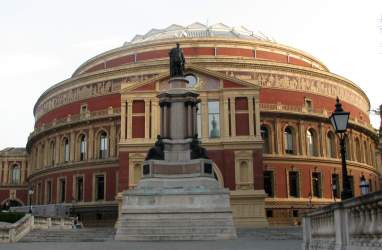 The Exhibition Memorial, with the Albert Hall behind.
The Exhibition Memorial, with the Albert Hall behind.
 The Exhibition Memorial, with the Albert Hall behind.
The Exhibition Memorial, with the Albert Hall behind.
The Memorial to the Great Exhibition, by the Albert Hall, is rather less well known than it deserves. Here we have a major monument - a crowning portrait statue of Prince Albert with four allegorical figures, all larger than lifesize bronzes - which somehow gets missed. The reason of course is that just to the other side of the Albert Hall, across the road, is the hugely more vast and opulent Albert Memorial itself. Having seen that, who is going to go behind the Albert Hall to see the smaller monument featuring the same person, on a scale seeming humble by comparison?
But we should look at the Exhibition memorial, by the notable sculptor John Durham, on its own merits. It is related to a model which in 1858 won a competition for a memorial to the Exhibition, as Britannia Presiding over the Four Quarters of the Globe, and in its translation to full size, the statue of Britannia was replaced by one to commemorate Prince Albert.
The statue of Albert is a noble figure, arguably more so than Foley's portrait statue for the Albert Memorial, which suffers from being gilt. Indeed, the smaller figure was considered splendid enough that a copy was made and installed in Guernsey in 1863, with a smaller pillar and without the subsidiary figures. There is a subtle balance to the figure, a nobility to the countenance, and a crispness of sharp detail to the figure which is characteristic of Durham.
Europe, America, Asia and Africa.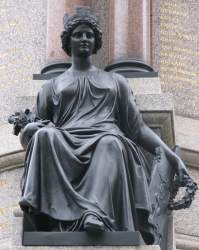
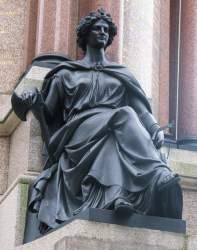
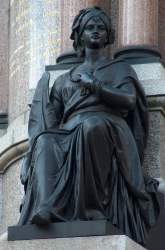
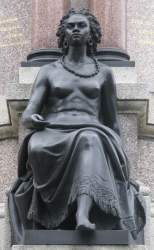
The four allegorical figures are Europe, America, Asia and Africa. These figures match the four groups on the Albert Memorial, and together, they illustrate what might be termed the Victorian 'hierarchy of drapery' - that civilised continents or countries are clothed, while barbaric ones are not. Europe, then, is generally properly dressed, being self-evidently civilised to the highest degree. For America the Victorian sculptor has a choice - pioneering America is typically clothed, Red Indian America, as it would have been termed then, Native American today, is generally not. Thus for the Exhibition Memorial, we have a clothed America, somewhat betwixt and between pioneering (holding an axe) and native (also holding a bow), while the principle figure for the Albert Memorial group is semi-nude, with two clothed female attendants, and unusually, a pioneer to the rear wearing but a loincloth. Perhaps a slightly ironical studied comment on the degree of civilisation in the new world. For Asia, the sculptor can choose the ancient civilisations of China or India (clad), or make the comparison of the poverty-striken Indian peasantry of the 19th century with more modern Europe (hence unclad). Durham's choice is India, clad, but an exotic, slightly barbaric civilisation as indicated by the jewellery, headdress and banana leaf. The Albert Memorial group also has India as the principal figure, equally exotic but semidraped, and all the attendant figures are fully draped. There is always the option to symbolise barbarity even more by adding a nose-ring, as in the figure of Asia on the front of the Foreign and Commonwealth Office. Finally Africa, almost always shown as uncivilised, as Foley has her, unless Egypt is chosen, as on the Albert Memorial, hence civilized but exotic. In the Albert Memorial case, the attendant figures include one with just a loincloth, while the African man gets only a g-string. As ever, the Foreign Office goes a step further, with the allegorical female figure of Africa having not just a paucity of clothing, but with the muscles of Hercules, dreadlocks, a naked infant, and a banana plant. Not to mention the grinning hippo. Today we can smile at the symbology, but I wonder how many African statesmen visiting the Foreign Office today, raise an eyebrow at the decoration on this building filled with diplomats.
But we digress. All of Durham's figures are excellent, the Asia best of all, to my eyes - what could be more splendid than her portrait, taking a classical Greek base, Victorianising it, around the nose and eyes, then giving the softness of cheek and chin of an Indian girl, topped with the splendid headdress of cloth and metal, feathers and beads, with a single ringlet of hair?
There are other things sculptural to see in the vicinity, apart from, of course, the Albert Memorial itself. The mosaic frieze running right round the Albert Hall includes designs by a number of eminent Victorian artists, and is worth study. There are some grand blocks around the Albert Hall, of which one, the Royal College of Organists, is much decorated in coloured tiles, rare in London compared to some of the northern cities, including a frieze of cherubs, and a roundel showing an organist. Standing next to the Exhibition Memorial and facing away from the Albert Hall, the Gothic pile down the steps and across the road, rather grand, is the Royal College of Music. And turning left, next to that building, is the Royal School of Mines entrance to Imperial College. Alas, the old Imperial College, a grand edifice from the 1860s, was demolished by the academic barbarians. However, in this northern wing, from a later date, we have two bulky sculptural groups, each with a bust of an eminent scientist (Beit and Wernher) on a short pillar, with two colossal figures at the base. They are the work of Paul R. Montford, and are comparable to his work for the Shrine of Remembrance in Melbourne (see picture here).
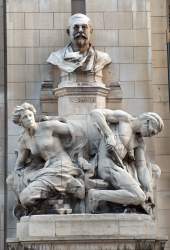
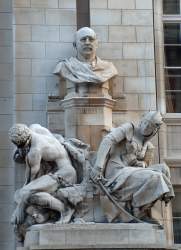 P. R. Montford's Wernher and Beit.
P. R. Montford's Wernher and Beit.
[This page was originally part of a 'sculpture of the month' series, for November 2011. Although the older pages in that series have been absorbed within the site, if you would wish to follow the original monthly series, then jump to the next month (December 2011) or the previous month (the first of the series - October 2011). Go to the bottom of each page where a paragraph like this one allows you to continue to follow the monthly links.]
Great Exhibition Memorial in the snow
South along Exhibition Road to see statues on the front of the V&A // North to the Albert Memorial
Visits to this page from 13 Mar 2014: 15,460